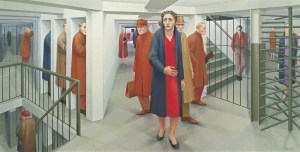In a neo-liberal post-WWII world governed by the United States, time is money. For the Japanese artist On Kawara (1932 – 2014), time is simply time. A consideration of his Date Paintings (1966 – 2014), shows the seriousness of his commitment to the theme, perhaps even his obsession. Having grown up in a convalescent Japan, one could imagine how his artistic production can bear some kind of traumatic charge or, at least, cause some kind of trauma. At first blush, it seems that his artworks, acting as signifiers of his stance on time, are as linear and equally pondered as his assessed conception of the subject. However, his conceptual position is much more intricate than its aesthetical form. Through an analysis of the aforementioned series, this article will unfold Kawara’s relationship with time.
As I consider Kawara’s Date Paintings as signs, a semiotic approach seems de rigueur. The sign has been defined by Ferdinand de Saussure in his Course in General Linguistics as being two-sided: relationship between a sound-image and a concept, or a signifier signifying a signified. Each one of Kawara’s Date Paintings doesn’t contain more than one color and the date of the day during which Kawara painted the canvas – the minimalist paintings consequently consist of two distinct signifiers, constituting Kawara’s language of color and form.
The succession of dates presented in the entirety of the Date Paintings series alludes to the linearity of measured time, as if time was an unbroken chain of multiple temporalized links. The simplicity of its formal vocabulary is, in this light, very effective: acting in a binary way, the viewer is constrained to reflect on the given day, or, on the other side of the coin, on every given day. This gap separating the two sides of the experience, and the impossibility to use the information painted on the canvas to reflect on the second side, makes the artwork revolve around itself: we are in front of a day, a day that has manifested itself entirely, without saying much – when presented alone – about the larger timeline it belongs to.
Despite its ambition to link the punctuality of the signifier with the vastness of the signified, the artwork confines the viewer within the depicted day because of his or her impossibility to go beyond the obvious with the help of the textual information alone. It is as if the signifier referred only to itself.
This artwork’s purpose is its manifestation; its ontology is its presence. We said earlier that the date was a signifier of time: the sign in itself, composed by the date and the concept it refers to, is empty because of the punctuality of the signifier compared to the immensity of its signified – as if the sand grain was to allude to the entire beach. This sign, a broken circle inasmuch as the connection between the signifier and the signified is forbidden by the length of their link, refers to nothing but itself and has no real essence: its purpose it to be here and then, not to signify the “here” and “then”.
The artwork is a trap; the viewer – encircled by his or her impotence – falls, insofar as it makes him or her believe that he or she is going to be able to cross this bridge with the date alone: it takes much more than a date to be able to sit next to Time. Because of this gap, each one of Kawara’s Date Paintings is fundamentally deceptive in the sense that it makes a promise it cannot hold: to make the viewer embark in a complete circle, starting from the signifier – the date – passing through the signified – Time – to return to the pictorial space. But in practice, the viewer is deceived because the information is lacking; holding a sand grain is not enough to digest the concept of the entire beach. The exclusivity and deceptiveness of the artwork seem to be at the basis of the cognitive experience when engaging with it; to some, it could appear as a way to denounce the very conception of time the series seems to embody.
This series being purely chronological, one could see each artwork as an embodiment of the concept of progress. In On the Concept of History, Walter Benjamin defines the “homogeneous and empty time” of positivism as being opposed to the “here-and now” – anyone who understands the progress of humanity as promised, due to the mass of facts that constitutes the past, inexorably adding up to instruct the human race about itself and its world, experiences an “homogeneous and empty time”; immobile, spineless, monotonous. On the other hand, the concept of the “here-and-now” entails the notion of ponderation.
One could see, in Kawara’s entire work, a sort of crystallisation of the former idea: an endless line of seemingly equal days and years, all equally tending toward the end of the timeline. The surface, the appearance of the work could be suitable for such an interpretation, but I believe Kawara’s “distanciation” – the separation of the signifier and the signified – itself acts as a signifier of his reticence about such a conception. The distance between the personality and its product as well as the gap between the signifier and the signified in his Date Paintings are as many signs of Kawara’s conflictual relationship with his favorite subject. Each artwork of his can be seen as a temporalized sign, presenting its deepness as well as its linearity.
And yet Kawara’s entire work acts as a denunciation of this conception of linearity; each artwork as an “act of resistance”, to borrow from Gilles Deleuze’s words: a struggle, a conflict against an established order. Kawara challenges the view of a unified time by problematizing its deepness, a deepness that is turned into an immense void through “distanciation”, emphasizing the gap between the signifier and its signified. What could be seen as the obedient repetitive act of a man overwhelmed by the vastness of time is in fact a bold challenge, as if he wanted to contain all of this vastness in aesthetically simple yet conceptually complex gestures.
His signs come from his persistent conflict with time: only the ever-puzzlement before the question asks for the gesture to be endlessly repeated. By being so close to a representation of the “homogeneous, empty time,” given the linearity of the practice and the formal equality of its products, Kawara’s demarche acts as its best denunciator.
The photo above shows how, along with the confection of the canvas, Kawara used to craft a box in which he pasted cuts of the local newspaper. “Any oppositional movement remains trapped in the logic of what it opposes”, thought Heidegger. One who thinks Heidegger is right could see Kawara’s art practice, so close to a materialization of the “homogeneous, empty” time, as its best challenger. Indeed, it is by the very virtue of its formal equality and overall linearity that Kawara’s art practice can challenge the linear and equal time it represents in the conceptual realm. Kawara’s artworks urge us to reconsider our vision of time by exposing its emptiness when taken as a linear string of un-pondered events.
His materialized meditation is the first step toward epiphany: the viewer must walk on the newly-opened path in order to attain it. For this task, he or she must consider each one of the Date Paintings as an insider denunciator: by being so close to the conception of time it aims at undertaking, its deceptiveness acts as a powerful argument against the aforementioned conception. On Kawara’s work comes full circle: a linearly temporalized practice resulting in formally flat and almost equal artworks which, through their traumatic charge (caused by the deceptiveness as well as the depersonalization), denounces the very conception of time it seems to allude to.
Timely pieces of information being overwhelming in his artworks, one can see how he separates these signifiers from their signified, and his personality from the formal rendering: in this closed circle that has no ontological meaning, this “distanciation”, as I call it, is traumatic for the viewer. This redundant artistic practice produces signs of “homogeneous, empty” time: nevertheless, the implied aggressiveness of his seemingly inoffensive artworks acts as a powerful denunciator of the very conception they seem to enforce.
Despite a bureaucratic aesthetic, Kawara expresses his reticence about a conception of time that would flatten the relative weights of events constituting a timeline, making history mute. By being expressed from the interior, the reticence is only made stronger, even though it is difficult to exhume. Once found, it rings loudly in the viewer’s mind — silently shouting, Kawara’s oeuvre is an aesthetically peaceful-yet-powerful alarm. Discretion is grace.




